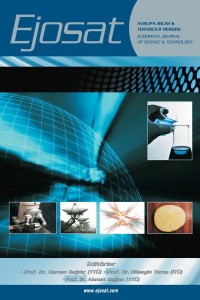Öz
Bu bildiride, elektromanyetik spektrumunda X bandında askeri uydu haberleşmesinde kullanılmak üzere tahsis edilmiş olan 7.2 – 8.4 GHz frekans aralıklarında çalışması için geniş bantlı ve yüksek kazanca sahip bir mikroşerit yama anten mikroşerit besleme tekniği ile tasarımı yapılmıştır. Bu tasarımda alttaş olarak kalınlığı 3.175mm, dielektrik katsayısı 2.2 ve tanjant kaybı(tan δ) 0.0009 olan Rogers RT/duroid 5880 malzemesi seçilmiş olup HFSS program üzerinde simülasyonu yapılmıştır. Nümerik yöntemler ile hesaplanan anten boyutları uygun frekans aralıklarında çalışması için ayarlanmasının zor olması nedeniyle yapay zeka optimizasyon algoritmalarının bir parçası olan genetik algoritma kullanılarak tasarlanmış antenin boyutlarının optimizasyonu yapılarak istenilen frekans aralıklarında çalışması sağlanmıştır. Tasarlanan anten simülasyon sonuçlarına göre 7.06 – 8.41 GHz frekans aralıklarında çalışmaktadır ve tasarlanan anten yaklaşık olarak 1.35 GHz = %17.25 bant genişliğine sahiptir. 7.825 GHz merkez frekansında antenin kazancı yaklaşık olarak 7.2 dB’ dir. Tasarlanan antenin bant genişliğini artırmak amacı ile antenin bakır ile kaplı yama ve mikroşerit beslemenin boyutları optimize edilerek ikinci bir anten tasarımı gerçekleştirilmiştir. Anten üzerinde yapılan değişiklikler sonucunda
tasarlanan ikinci anten 6.74 – 9.69 GHz frekans aralıklarında çalışmaktadır ve tasarlanan anten yaklaşık olarak 2.95 GHz = % 37.7 bant genişliğine sahiptir. 7.825 GHz merkez frekansında antenin kazancı yaklaşık olarak 6.63 dB’ dir.
Anahtar Kelimeler
Mikroşerit Yama Anten Genetik Algoritma HFSS Askeri Uydu Haberleşmesi Anten Tasarımı X-Bant Geniş Bant
Kaynakça
- Bahl, I. J., & Bhartia, P. (1980). Microstrip Antennas
- Carver, K. R., & Mink, J. W. (1981). Microstrip Antenna Technology. IEEE Trans. Antennas Propagat., Ap-29(1), 2-24
- Deschamps, G. A. (1953). Microstrip Microwave Antennas. Presented at the Third USAF Antenna Symposium
- HOLLAND, J. H. (1975). Adaption in Natural and Artificial Systems
- Katehi, P. B., & Alexopoulos, N. G. (1984). On the Modeling of Electromagnetically Coupled Microstrip Antennas The Printed Strip Dipole. AP 32(11), 1179-1186
- Munson, R. (1974). Conformal microstrip antennas and microstrip phased arrays. IEEE Transactions on Antennas and Propagation 22 , 74-78
- Pozar, D. M. (1992). Microstrip Antennas. IEEE , 80(1) 1), s. 79-81
- Warren, L., & Gary, A. (1998). Antenna Theory and Design
Öz
In this paper, a broadband and high gain microstrip patch antenna was designed with a microstrip feeding technique to operate in the electromagnetic spectrum in the X band in the frequency range of 7.2 8.4 GHz, which is allocated for use in military sate llite communication. In this design, Rogers RT / duroid 5880 material with a thickness of 3.175mm, dielectric coefficient of 2.2 and tangent loss (tan δ) of 0.0009 was selected and simulated on the HFSS program. Since the antenna sizes calculated by numerical methods are difficult to adjust to operate in appropriate frequency ranges, the dimensions of the antenna designed using the genetic
algorithm, which is a part of artificial intelligence optimization algorithms, have been optimized to work in the desir ed frequency ranges. According to the designed antenna simulation results, it operates in the frequency ranges of 7.06 8.41 GHz and the designed antenna has a bandwidth of approximately 1.35 GHz = 17.25%. At 7.825 GHz center frequency, the antenna's gain is approximately 7.2 dB. In order to increase the bandwidth of the designed antenna, a second antenna design was realized by optimizing the dimensions of the antenna covered with copper and microstrip feeding. The second antenna designed as a result of th e changes made
on the antenna operates in the frequency ranges of 6.74 9.69 GHz and the designed antenna has a bandwidth of approximately 2.95 GHz = 37.7%. At the central frequency of 7.825 GHz, the antenna's gain is approximately 6.63 dB.
Anahtar Kelimeler
Microstrip Patch Antenna Genetic Algorithm HFSS Military Satellite Communication Antenna Design X-Band Broadband
Kaynakça
- Bahl, I. J., & Bhartia, P. (1980). Microstrip Antennas
- Carver, K. R., & Mink, J. W. (1981). Microstrip Antenna Technology. IEEE Trans. Antennas Propagat., Ap-29(1), 2-24
- Deschamps, G. A. (1953). Microstrip Microwave Antennas. Presented at the Third USAF Antenna Symposium
- HOLLAND, J. H. (1975). Adaption in Natural and Artificial Systems
- Katehi, P. B., & Alexopoulos, N. G. (1984). On the Modeling of Electromagnetically Coupled Microstrip Antennas The Printed Strip Dipole. AP 32(11), 1179-1186
- Munson, R. (1974). Conformal microstrip antennas and microstrip phased arrays. IEEE Transactions on Antennas and Propagation 22 , 74-78
- Pozar, D. M. (1992). Microstrip Antennas. IEEE , 80(1) 1), s. 79-81
- Warren, L., & Gary, A. (1998). Antenna Theory and Design
Ayrıntılar
| Birincil Dil | İngilizce |
|---|---|
| Konular | Mühendislik |
| Bölüm | Makaleler |
| Yazarlar | |
| Yayımlanma Tarihi | 5 Ekim 2020 |
| Yayımlandığı Sayı | Yıl 2020 Ejosat Özel Sayı 2020 (ICCEES) |


